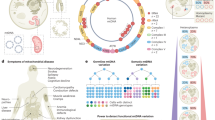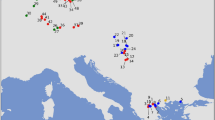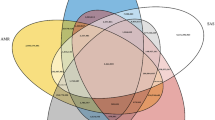Abstract
Selections on human mitochondrial variations are difficult to examine. In this study, we found possible signs of selection on mitochondrial M7 lineages among the Gelong people who migrated from Guizhou to Hainan (the hottest province in China) throughout the last 1000 years. The genetic structure of the Gelong people shows an obvious sex-biased population admixture pattern with only 4.9% paternal contribution but 30.7% maternal contribution from indigenous Hlai people. According to frequency spectrum tests for deviation from neutrality and mismatch tests of demographic expansion, part of the maternal mitochondrial M7 lineages among the Gelong came from the Hlai had spread quickly and therefore might have undergone positive selection. In the future, whole mitochondrial genome sequencing might reveal the functional advantage of the M7 lineages.
Similar content being viewed by others
Log in or create a free account to read this content
Gain free access to this article, as well as selected content from this journal and more on nature.com
or
Accession codes
References
Wen, B., Xie, X., Gao, S., Li, H., Shi, H., Song, X. et al. Analyses of genetic structure of Tibeto-Burman populations reveals sex-biased admixture in southern Tibeto-Burmans. Am. J. Hum. Genet. 74, 856–865 (2004).
Li, D., Sun, Y., Lu, Y., Mustavich, L. F., Ou, C., Zhou, Z. et al. Genetic origin of Kadai-speaking Gelong people on Hainan Island viewed from Y chromosomes. J. Hum. Genet. 55, 462–468 (2010).
Li, H., Cai, X. Y., Winograd-Cort, E. R., Wen, B., Cheng, X., Qin, Z. D. et al. Mitochondrial DNA diversity and population differentiation in southern East Asia. Am. J. Phys. Anthropol. 134, 481–488 (2007).
Wen, B., Li, H., Lu, D., Song, X., Zhang, F., He, Y. et al. Genetic evidence supports demic diffusion of Han culture. Nature 431, 302–305 (2004).
van Oven, M. & Kayser, M. Updated comprehensive phylogenetic tree of global human mitochondrial DNA variation. Hum. Mut. 30, E386–394 (2009).
Excoffier, L., Laval, G. & Schneider, S. Arlequin (version 3.0): an integrated software package for population genetics data analysis. Evol. Bioinform. Online 1, 47–50 (2005).
Dupanloup, I. & Bertorelle, G. Inferring admixture proportions from molecular data: extension to any number or parental populations. Mol. Biol. Evol. 18, 672–675 (2001).
Li, H., Wen, B., Chen, S. J., Su, B., Pramoonjago, P., Liu, Y. et al. Paternal relationships between Austronesian and Daic populations. BMC Evol. Biol. 8, 146 (2008).
Wen, B., Li, H., Gao, S., Mao, X. Y., Gao, Y., Li, F. et al. Genetic structure of Hmong-Mien speaking populations in East Asia as revealed by mtDNA lineages. Mol. Biol. Evol. 22, 725–734 (2005).
Bandelt, H. J., Forster, P. & Rohl, A. Median-joining networks for inferring intraspecific phylogenies. Mol. Biol. Evol. 16, 37–48 (1999).
Tajima, F. Statistical-method for testing the neutral mutation hypothesis by DNA polymorphism. Genetics 123, 585–595 (1989).
Fu, Y. X. & Li, W. H. Statistical tests of neutrality of mutations. Genetics 133, 693–709 (1993).
Fu, Y. X. Statistical tests of neutrality of mutations against population growth, hitchhiking and background selection. Genetics 147, 915–925 (1997).
Librado, P., Rozas, J. & Dna, S. P. v5: a software for comprehensive analysis of DNA polymorphism data. Bioinformatics 25, 1451–1452 (2009).
Hudson, R. R. Generating samples under a Wright-Fisher neutral model of genetic variation. Bioinformatics 18, 337–338 (2002).
Schaffner, S. F., Foo, C., Gabriel, S., Reich, D., Daly, M. J. & Altshuler, D. Calibrating a coalescent simulation of human genome sequence variation. Genome Res. 15, 1576–1583 (2005).
Helgason, A., Pálsson, S., Thorleifsson, G., Grant, S. F. A., Emilsson, V., Gunnarsdottir, S. et al. Refining the impact of TCF7L2 gene variants on type 2 diabetes and adaptive evolution. Nat. Genet. 39, 218–225 (2007).
Soares, P., Ermini, L., Thomson, N., Mormina, M., Rito, T., Röhl, A. et al. Correcting for purifying selection: an improved human mitochondrial molecular clock. Am. J. Hum. Genet. 84, 740–759 (2009).
Schneider, S. & Excoffier, L. Estimation of past demographic parameters from the distribution of pairwise differences when the mutation rates vary among sites: application to human mitochondrial DNA. Genetics 152, 1079–1089 (1999).
Acknowledgements
We thank all of those who donated samples. Our research was supported by the National Natural Science Foundation of China (30860124, 30890034, 31071098), Natural Science Foundation of Hainan (061014), Natural Science Foundation of Shanghai (10ZR1402200), Shanghai Committee of Education Research Innovation Key Project (11zz04), National Outstanding Youth Science Foundation of China (30625016), Shanghai Leading Academic Discipline Project and the Genographic project.
Author information
Authors and Affiliations
Consortia
Corresponding authors
Additional information
Supplementary Information accompanies the paper on Journal of Human Genetics website
Supplementary information
Appendix
Appendix
The Genographic Consortium: Syama Adhikarla1, Christina J Adler2, Elena Balanovska3, Oleg Balanovsky3, Doron M Behar4, Jaume Bertranpetit5, Andrew C Clarke6, David Comas5, Alan Cooper2, Clio SI Der Sarkissian2, Matthew C Dulik7, Christoff J Erasmus8, Jill B Gaieski7, ArunKumar GaneshPrasad1, Wolfgang Haak2, Angela Hobbs8, Asif Javed9, Matthew E Kaplan10, Begoña Martínez-Cruz5, Elizabeth A Matisoo-Smith6, Marta Melé5, Nirav C Merchant10, R John Mitchell11, Amanda C Owings7, Laxmi Parida9, Ramasamy Pitchappan1, Daniel E Platt9, Lluis Quintana-Murci12, Colin Renfrew13, Daniela R Lacerda14, Ajay K Royyuru9, Fabrício R Santos14, Theodore G Schurr7, Himla Soodyall8, David F Soria Hernanz15, Pandikumar Swamikrishnan16, Chris Tyler-Smith17, Kavitha Valampuri John1, Arun Varatharajan Santhakumari1, Pedro Paulo Vieira18, Janet S Ziegle19 and R Spencer Wells15
Affiliations for participants: 1Madurai Kamaraj University, Madurai, Tamil Nadu, India. 2University of Adelaide, South Australia, Australia. 3Research Centre for Medical Genetics, Russian Academy of Medical Sciences, Moscow, Russia. 4Rambam Medical Center, Haifa, Israel. 5Universitat Pompeu Fabra, Barcelona, Spain. 6University of Otago, Dunedin, New Zealand. 7University of Pennsylvania, Philadelphia, PA, USA. 8National Health Laboratory Service, Johannesburg, South Africa. 9IBM, Yorktown Heights, NY, USA. 10University of Arizona, Tucson, AZ, USA. 11La Trobe University, Melbourne, Victoria, Australia. 12Institut Pasteur, Paris, France. 13University of Cambridge, Cambridge, UK. 14Universidade Federal de Minas Gerais, Belo Horizonte, Minas Gerais, Brazil. 15National Geographic Society, Washington, DC, USA. 16IBM, Somers, NY, USA. 17The Wellcome Trust Sanger Institute, Hinxton, UK. 18Universidade Federal do Rio de Janeiro, Rio de Janeiro, Brazil. 19Applied Biosystems, Foster City, CA, USA.
Rights and permissions
About this article
Cite this article
Yang, K., Zheng, H., Qin, Z. et al. Positive selection on mitochondrial M7 lineages among the Gelong people in Hainan. J Hum Genet 56, 253–256 (2011). https://doi.org/10.1038/jhg.2010.165
Received:
Revised:
Accepted:
Published:
Issue date:
DOI: https://doi.org/10.1038/jhg.2010.165
Keywords
This article is cited by
-
Patterns of natural selection acting on the mitochondrial genome of a locally adapted fish species
Genetics Selection Evolution (2015)



